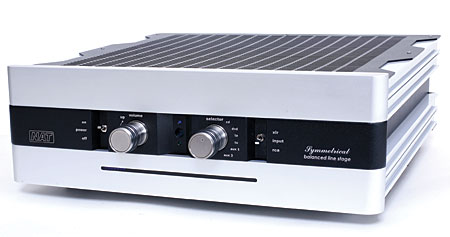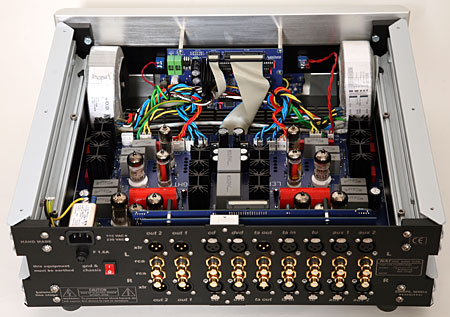| Columns Retired Columns & Blogs |
NAT Symmetrical line preamplifier
Sometimes, a product review in Stereophile can breed additional reviews. Shortly after I reviewed the Audio Valve Conductor line stage in the July 2009 issue (Vol.32 No.7), I was contacted by NAT's US distributor, Musical Sounds: "Hey, if you liked the Audio Valve Conductor [$13,995], you'll love the NAT Symmetrical line stage at $8000! Would you like to review it?" Aside from Michael Fremer's review of the battery-powered NAT Signature Phono stage in the July 2007 issue, I was unfamiliar with this Serbian maker of tube electronics. But "Sure," I replied; "why not?"
Footnote 1: Do you really need more? My wife and I constantly argue over which of the three Menu buttons on my Blu-ray player's 50-button remote actually calls up the menu.

Designing
Dejan Nikic has designed tube electronics for NAT Audio since 1993. Their current product line consists of three tubed preamplifiers, a tubed phono stage, five tubed monoblock power amplifiers, a hybrid integrated amp, and three power cords. The visually striking Magma, a single-ended, class-A monoblock, uses a single TH450 tube and costs $45,000/pair. NAT claims that this amplifier, at 160W, is currently the most powerful single-ended amplifier ever made to use a single tube in its output stage. At $8000, the Symmetrical line stage is not the most expensive preamp in NAT's product line; that honor belongs to the dual-chassis Utopia line stage ($9000).
The Symmetrical's dual-mono, fully balanced circuit includes 12 tubes (6 per channel) operating in pure class-A triode configuration with zero loop feedback. The signal path for each channel has a 6N30P-DR and a 6N1P-VI tube, uses a 6X4WA tube as a power-supply rectifier, and an OA2 as a power-supply plasma-effect stabilizer. All tubes are military-spec new old stock (NOS) and are available from NAT and other tube retailers. The Symmetrical also includes custom-made toroidal transformers, as well as high-capacitance, audiophile-grade capacitors in the signal path and polypropylene capacitors in the high-voltage power supply. Nikic explained to me the Symmetrical has a sufficiently low output impedance to allow it to drive even a 600 ohm load, which he feels is unusual for a pure tube design. He also believes that the preamp's performance will not vary with either volume-control setting or under a wide range of power-supply voltages.
Describing
On the rear panel are five inputs, a tape monitor loop, and two outputs, with single-ended and balanced options for each input and output. All inputs and outputs have gold-plated, Teflon-insulated RCA jacks and gold-plated XLR (XLR) connectors. There's also a neat switch that gives you the option of grounding the line stage to its chassis, in case that results in less hum. In terms of tube noise and hum, I found the Symmetrical dead quiet throughout my listening sessions.
The Symmetrical's rugged-looking yet elegant faceplate of solid aluminum has two knobs: One controls the volume, and is also a pushbutton for the Mute function; the other is an input selector. Each knob is encircled by two rubber O-rings; handling the knobs, all I felt was the rubber—a cute feature. The knobs are flanked by two toggle switches, one for power, and one to switch between single-ended and balanced operation. The small remote control, of solid aluminum, sports only three large buttons: Volume Up and Down, and Mute (footnote 1). Two large heatsinks also serve as the sidepanels.

I used all single-ended input sources into the NAT, and a balanced output into my Audio Research Reference 110 amplifier. I found two aspects of the Symmetrical's operation to be somewhat unusual. Both the volume-control knob on the line stage and the buttons on the remote trigger a series of computer-controlled relays that set the volume level, which is displayed via a series of blue lights along the bottom of the faceplate. As changing the volume causes a series of relays to switch on and off, with no signal being passed during the relay switching process, there will be a few milliseconds of silence between each two steps of volume level. Thus there is a bit of stuttering chatter as the preamp cuts in and out while the volume is being changed, which I got used to rather quickly.
A more annoying feature was the Symmetrical's silent turn-on mode. When the preamp is turned on, it remains Muted while its tubes warm up. During this period the volume setting gradually decreases to zero from whatever the previous setting was; then the preamp comes out of Mute. Thus, every time you turn on the preamp, you need to chatter back up to find your original volume level. A much more convenient and elegant solution would have been to implement something like Audio Research uses in its VSi60 tube integrated amplifier (review to come): during warmup, the amplifier remains in Mute with the volume level constant; the user then needs to manually unMute it.
Listening
Listening to the NAT Symmetrical stimulated me to think about how much the state of the art of tubed preamps has advanced since I began listening to and comparing them nearly three decades ago. In the early 1980s, three manufacturers dominated the tube-preamp landscape: Audio Research, Conrad-Johnson, and the now-defunct Counterpoint. Each company's flagship products had a strong personality, a sonic signature that represented the designer's interpretation of tonal balance, soundstage reproduction, and rendering of transients. And each of these manufacturers had a cult following—only rarely would an AR guy consider buying a C-J product, and vice versa. I never joined any of those cults, however; I've owned multiple preamplifiers and amplifiers made by AR and C-J over the years, and at one point came close to buying a Counterpoint MC step-up preamp.
Footnote 1: Do you really need more? My wife and I constantly argue over which of the three Menu buttons on my Blu-ray player's 50-button remote actually calls up the menu.
- Log in or register to post comments




































